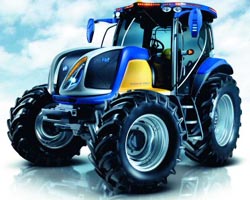New Holland NH2 Hydrogen-Powered Tractor
TractorData -New Holland revealed the NH2 hydrogen-powered tractor at the SIMA Agri-Business show in Paris. The experimental tractor is based on the T6000 platform and is part of New Holland's Energy Independent Farm concept.
The NH2 uses hydrogen fuel cells to generate electricity. Hydrogen is stored in a high-pressure (5,000 PSI) tank. This hydrogen from the tank and oxygen from the air are passed over electrodes, producing electricity. This power is directed to two electric motors, one for the continuously variable transmission (CVT) and the other for the power take-off (PTO) and auxiliary services. The fuel cell generates 106 horsepower (75 kW) and water is the only exhaust.
At this time, the tractor is purely experimental. The hydrogen tank allows for less than two hours of operation and the fuel cell is estimated to cost over $350,000. New Holland has indicated that future improvements may include an entirely new tractor design and the use of electricity to replace hydraulics and the PTO.
 The NH2 is not the first fuel cell tractor. In 1959, Allis-Chalmers unveiled an experimental tractor using a 20 horsepower (15 kW) propane/oxygen fuel cells to power the transmission of a modified D12. The high cost of the fuel cell made the machine impractical for production. The Allis fuel cell tractor is now at the Smithsonian Institute.
The NH2 is not the first fuel cell tractor. In 1959, Allis-Chalmers unveiled an experimental tractor using a 20 horsepower (15 kW) propane/oxygen fuel cells to power the transmission of a modified D12. The high cost of the fuel cell made the machine impractical for production. The Allis fuel cell tractor is now at the Smithsonian Institute.
The use of electric implements also has precedent, in International Harvester's Electrall system that was available on Farmall and IH tractors in the mid-1950s. The Electrall system featured a 37 ampere generator (manufactured by General Electric) powered from the tractor's engine. This unit would then operate electrically powered implements, or as a mobile generator for stationary equipment. International marketed the system as being safer than the mechanical PTO because there was no moving shaft between the tractor and the implement.
